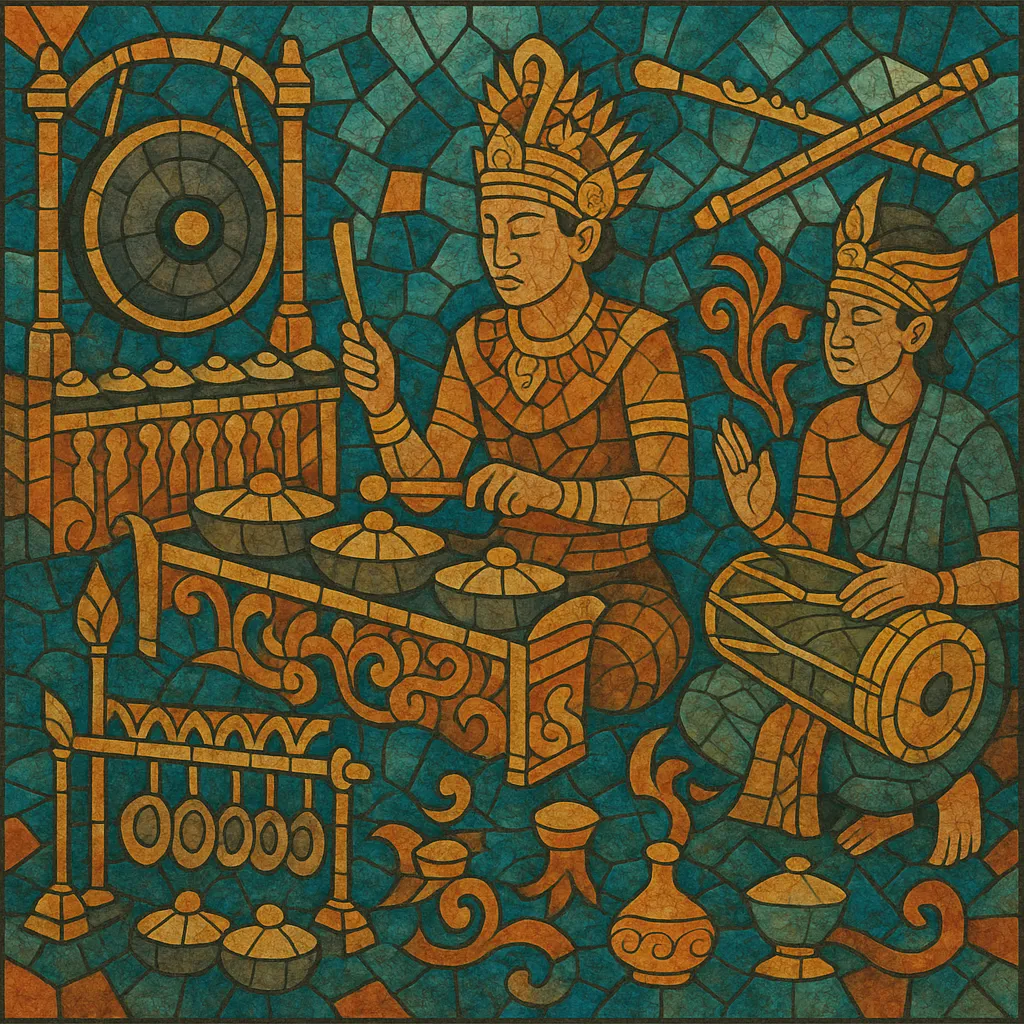Gamelan gong kebyar is a modern Balinese gamelan ensemble and repertory whose name kebyar (“to flare up, to burst open”) captures its hallmark aesthetic: sudden flashes of sound, dazzling virtuosity, and extreme dynamic contrasts.
It features tightly interlocking figurations (kotekan), explosive cue accents (angsel), rapid tempo shifts, and a brilliant, shimmering sonority created by paired bronze instruments tuned with intentional beating (ombak). Typical instrumentation includes bronze metallophones (gangsa: kantilan, pemade, and the leading ugal), the reyong (a row of small knobbed gongs) and/or trompong, large gongs (gong ageng, kempur, kemong), time-keeping kajar, ceng-ceng cymbals, kendang lanang/wadon drum pair, and color from suling bamboo flutes.
Tuning and melody draw on five-tone Balinese modal subsets (e.g., selisir, tembung, sunaren, pengenter, baro) derived from pelog, articulated within cyclical gong punctuation. The style accompanies iconic 20th‑century dances (such as Kebyar Duduk and Teruna Jaya), temple festivals, and concert presentations, and has become the default platform for contemporary Balinese composition (kreasi baru).
Gamelan gong kebyar arose in North Bali (notably Buleleng) around 1915, in the wake of shifting social and courtly structures. Musicians adapted and reconfigured instruments and repertories from older Balinese ensembles—especially the stately court style of gamelan gong gede—into a more compact, virtuosic, and theatrically dynamic idiom. Early public notoriety for the new style came during village competitions and festivals where its brilliance and sudden “flaring” gestures stood out.
Through the 1920s and 1930s, the style spread rapidly across Bali, becoming the island’s most prominent ensemble. Composers and dancer-choreographers forged signature works and techniques: interlocking kotekan textures, explosive angsel cues, and vivid dynamic contrasts. Iconic dance works like Kebyar Duduk (choreography associated with I Ketut Mario) and showpieces such as Teruna Jaya became emblematic of the idiom and cemented gong kebyar’s link with modern Balinese dance-theater.
After Indonesian independence, arts schools (later ISI Denpasar and related institutions) and island-wide festivals (e.g., Pesta Kesenian Bali) standardized training and nurtured continual innovation. Gong kebyar became the principal vehicle for kreasi baru (new creations), encouraging composers to expand modal usage, texture, and theatricality while retaining cyclical colotomic frameworks and stratified textures.
From the mid‑20th century onward, international tours, recordings, and collaborations brought gong kebyar to global audiences. Ethnomusicologists and composers (notably Colin McPhee and later generations) disseminated its concepts, shaping Western ensembles and repertoires (e.g., American gamelan) and informing aspects of contemporary classical and minimalist practice, all while Balinese masters continued to evolve the style at home.
Assemble a standard gong kebyar ensemble: paired bronze metallophones (kantilan, pemade, ugal), reyong (and/or trompong), large gongs (gong ageng, kempur, kemong), kajar (timekeeper), ceng-ceng cymbals, kendang lanang/wadon drums, and optional suling flutes. Seat players facing each other for precise interlocking.
Use paired tuning with slight detuning between instrument pairs to create ombak (shimmer). Compose within Balinese five-tone modal subsets (e.g., selisir, tembung, sunaren, pengenter, baro), treating pitch content relationally rather than via Western harmony.
Layer a core melody (pokok) in lower instruments and elaborate it using kotekan: write complementary polos and sangsih parts that interlock at high speed. Employ idiomatic figurations (e.g., norot, oncangan) and vigorous reyong patterns. Keep the kajar steady while allowing dramatic tempo inflections under kendang leadership.
Organize music in cyclical colotomic forms punctuated by kemong/kempur and resolved by the gong ageng. Craft sudden dynamic shifts and rests, then signal explosive re-entries using angsel drum cues. Balance episodes of virtuosic passagework with more lyrical, spacious sections for contrast.
Let the ugal lead the melody and cue transitions; distribute bright gangsa figurations across registers. Use ceng-ceng to articulate climaxes and dense textures to support dance. Write drum patterns in male/female pairings (lanang/wadon) to shape phrasing, tempo, and form.
Coordinate musical angsel and tempo rubato with choreographic accents (e.g., in Kebyar Duduk or Teruna Jaya). Compose clear cue points and cadences to match gesture, narrative pacing, and stagecraft.


